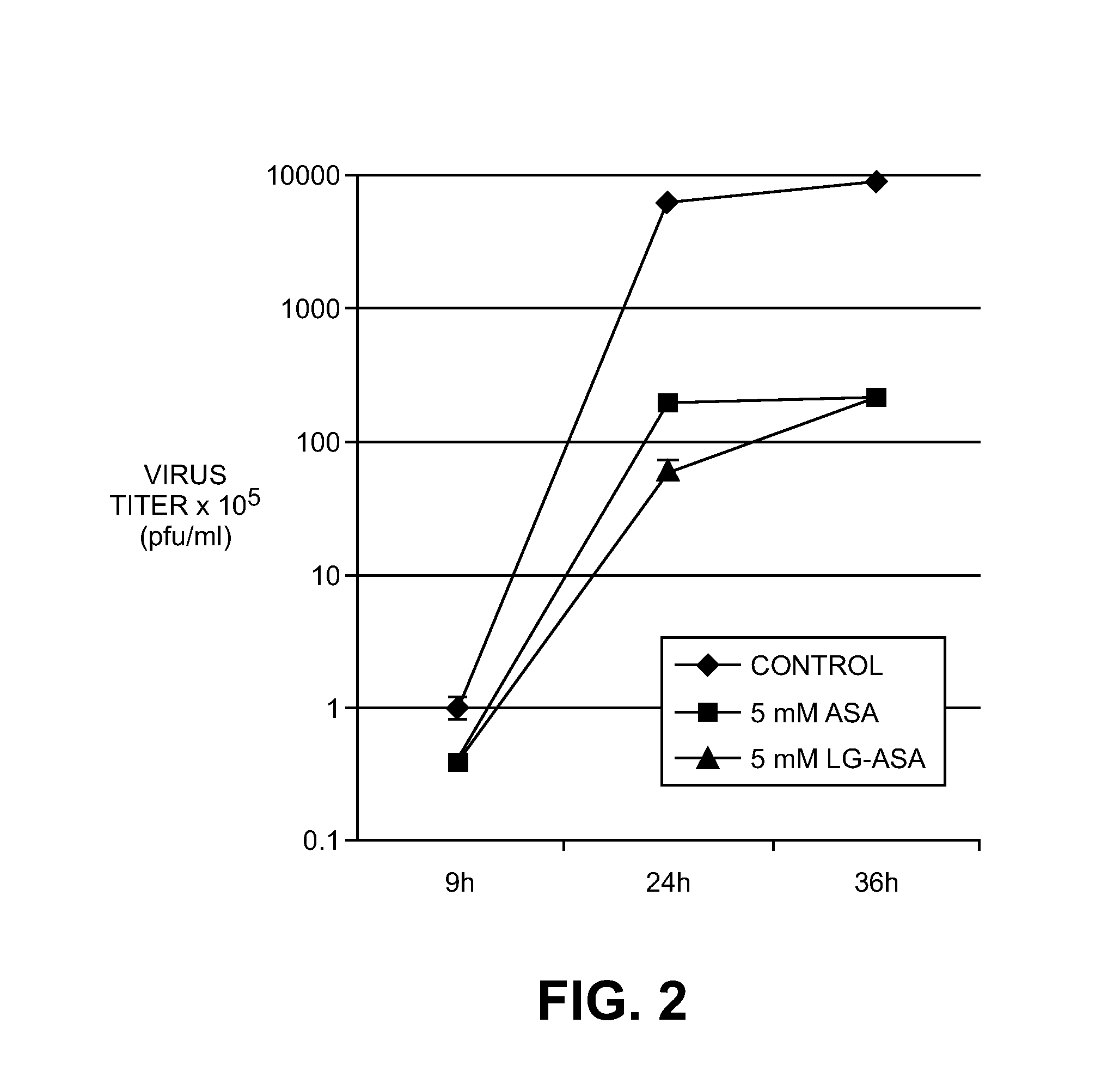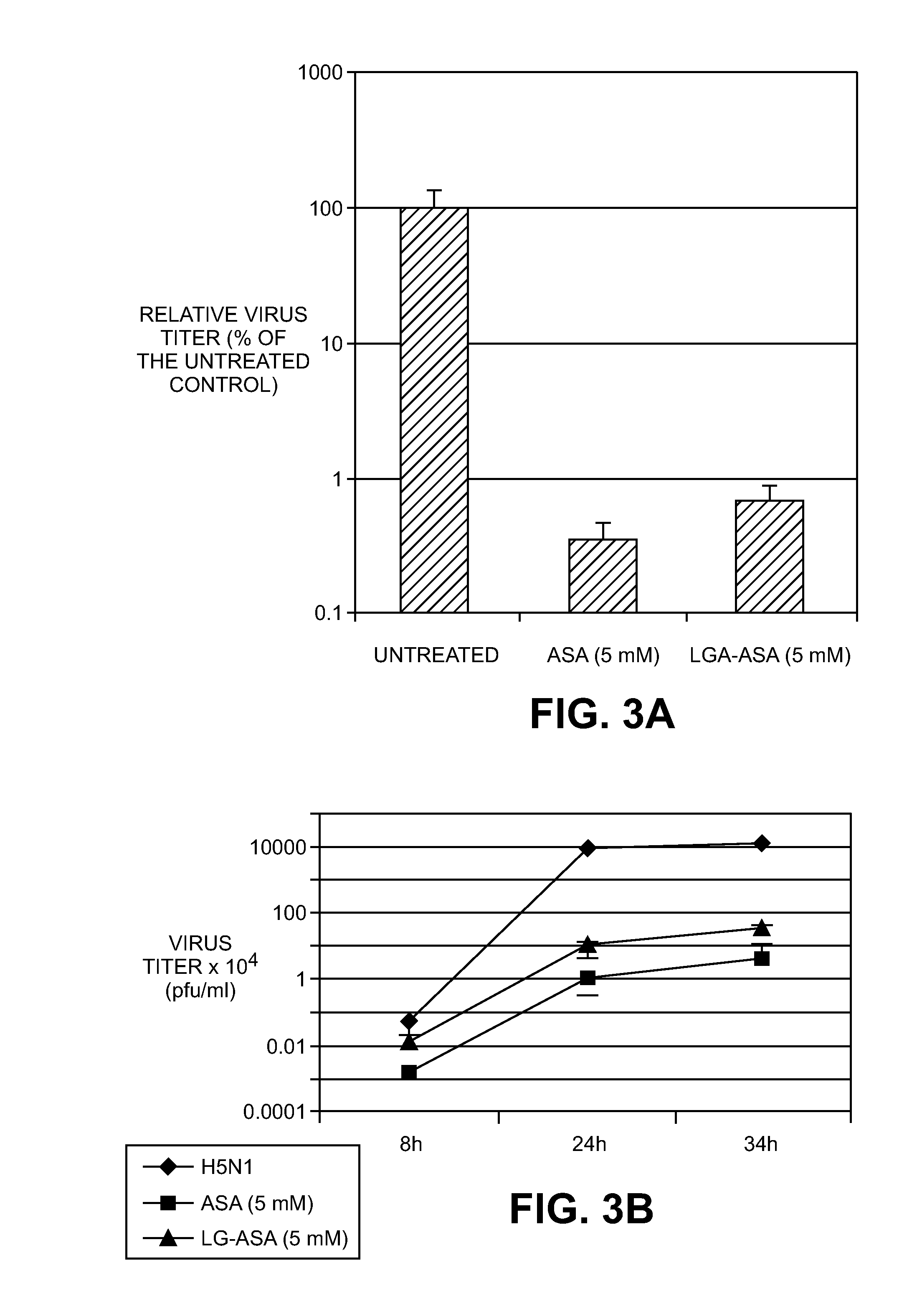Use of salt of an acetylsalicylic acid for the treatment of viral infections
a technology of acetylsalicylic acid and salt, which is applied in the direction of antibody medical ingredients, aerosol delivery, peptide/protein ingredients, etc., can solve the problems of avian influenza epidemically growing in fowl, affecting the survival rate of poultry, and being transmissible to humans, so as to avoid the risk of induction of asthma attacks and be well tolerated
- Summary
- Abstract
- Description
- Claims
- Application Information
AI Technical Summary
Benefits of technology
Problems solved by technology
Method used
Image
Examples
example 2
Investigation of the Formulation Lysine-Glycine-Acetylsalicylate for Antiviral Activity Against Highly Pathogenic Influenza A Viruses
[0034]The investigated composition is lys-gly-acetylsalicylate (in the following also called LG-acetylsalicylate), which corresponds to the molecular composition of the product Aspisol®, available from Bayer AG.
[0035]This formulation was subjected to the investigations for antiviral activity against influenza viruses. A549 lung epithelial cells were infected with A / FPV / Bratislava / 79 (H7N7) (MOI=0.01) and incubated for 8 h, 24 h and 36 h in presence or absence of acetylsalicylic acid (5 mM) or LG-acetylsalicylate (5 mM). The cell supernatant of each sample was then collected, and the viral titer in the plaque assay on MDCK cells was determined therefrom. FIG. 2 shows a plot of the virus titers versus time. The result is that LG-acetylsalicylate equally efficiently inhibits the virus multiplication of the highly pathogenic avian H7N7 isolate as acetylsa...
example 3
Influence of LG-acetylsalicylate on Highly Pathogenic Avian Influenza Viruses in the Cell Culture System
[0038]MDCKII cells were cultivated in MEM medium (MEM; Gibco (Invitrogen) Germany 21430-079, lot 32034) with the addition of 10% heat-deactivated fetal calf serum (FCS, PAA Laboratories / A04305-0346), penicillin (Grünenthal / 616G03) and streptomycin (Sanavita / 03056440111). For the infection the cells were sown in 24-well plates (8×104 cells / well; Greiner, Germany, No. 662160, lot 05210151) and incubated over night at 37° C. Before the infection, the cells were washed with PBS, the corresponding virus (FPV, SN1, MB1) was diluted in PBS / BA (PBS supplemented with 0.6% BA (MP Biomedicals), 1 mM MgCl2, 0.9 mM CaCl2, penicillin (Grünenthal / 616G03) and streptomycin and pipetted with an MOI of 0.001 on the cell lawn. After an incubation time of 30 min at 37° C., the virus inoculum was removed, to the cells was added either 1 ml MEM medium or MEM medium, which contained 5 mM LG-acetylsalicyl...
example 4
Investigation of the Molecular Mechanisms of Action the Antiviral Activity of LG-Acetylsalicylate is Based on
[0041]Further, it was investigated whether the molecular profile of action of LG-acetylsalicylate is comparable with that of the pure substance acetylsalicylic acid. LG-acetylsalicylate should act as an NF-κB inhibitor and correspondingly not have any side effects on other virus-induced signal pathways. An important group of signal mediators, which are also activated after influenza virus infection, are the so-called mitogen-activated protein kinases (MAPK). Thereto belong the kinases JNK, p38 and ERK. For the pure substance acetylsalicylic acid, it has already been shown that the virus-induced activation of these kinases is not inhibited by acetylsalicylic acid. As FIG. 5 shows, this is also the case for LG-acetylsalicylate: the virus-induced activation of JNK, p38 and ERK (FIG. 5, track 5), which can be detected by means of phosphor-specific antibodies against the active f...
PUM
| Property | Measurement | Unit |
|---|---|---|
| time | aaaaa | aaaaa |
| time | aaaaa | aaaaa |
| time | aaaaa | aaaaa |
Abstract
Description
Claims
Application Information
 Login to View More
Login to View More - R&D
- Intellectual Property
- Life Sciences
- Materials
- Tech Scout
- Unparalleled Data Quality
- Higher Quality Content
- 60% Fewer Hallucinations
Browse by: Latest US Patents, China's latest patents, Technical Efficacy Thesaurus, Application Domain, Technology Topic, Popular Technical Reports.
© 2025 PatSnap. All rights reserved.Legal|Privacy policy|Modern Slavery Act Transparency Statement|Sitemap|About US| Contact US: help@patsnap.com



